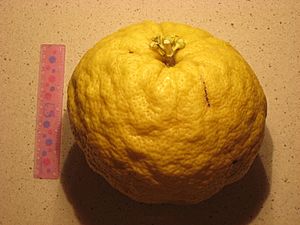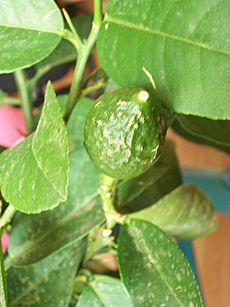Ponderosa lemon facts for kids
Quick facts for kids Ponderosa lemon |
|
|---|---|
 |
|
| Scientific classification | |
| Kingdom: | |
| (unranked): | |
| (unranked): | |
| (unranked): | |
| Order: | |
| Family: | |
| Genus: | |
| Species: |
C. × pyriformis
|
| Binomial name | |
| Citrus × pyriformis |
|
The ponderosa lemon (Citrus × pyriformis) is a special type of citrus fruit. It's actually a hybrid (a mix) of two other fruits: a pomelo and a citron. Sometimes people call it the Skierniewice lemon. Even though it looks a bit like a lemon, it's not a "true" lemon because it doesn't have any mandarin orange in its family tree.
Contents
What is a Ponderosa Lemon?
Ponderosa lemon trees grow slowly. When they are fully grown, they can reach a height of about 12 to 24 feet (3.6 to 7.3 meters). Their leaves are long and shiny. They are also evergreen, which means they stay green all year round. The leaves are shaped like an oval with pointed ends and smell like lemons.
The branches of the Ponderosa lemon tree are quite thick. They have many spines, so be careful! When new leaves or flowers grow, they often have a pretty purple tint. The flowers are bigger than those of most other citrus plants. A cool thing about this tree is that it can grow fruit all year long.
If someone grows a Ponderosa lemon tree just for its looks (as an ornamental plant), they might need to trim it. This helps keep its shape nice. You can even train it to grow as a bush or a small tree.
Fruit and Cold Hardiness
The Ponderosa lemon is not as strong against cold weather as a regular lemon. This means it needs warmer places to grow well.
Its fruit is medium to large in size. It has a thick, bumpy rind (the skin). Inside, the fruit has many seeds. Even though it might look a bit like a citron, it tastes just like a lemon.
Where Did Ponderosa Lemons Come From?
The Ponderosa lemon first appeared around the year 1887. People believe it grew from a chance seedling in Hagerstown, Maryland. A "chance seedling" means it grew by accident, not because someone planted it on purpose. It was given its name and introduced to plant nurseries in 1900.
In Poland, a plant expert named Szczepan Pieniążek helped make these lemons popular. He called them Skierniewice lemons. He encouraged people to grow them in their homes. This was important because it was hard to get imported fruits in Poland at that time.
Family Tree of the Ponderosa Lemon
For a long time, people thought the Ponderosa lemon was a mix of a lemon and a citron. But new science, looking at its DNA, showed something different. It only has DNA from pomelo (Citrus maxima) and citron (Citrus medica). This means it's likely a second-generation hybrid (an F2 hybrid) of these two fruits. This also proves it can't be from "true" lemons, because true lemons have some mandarin orange in their background.
How Ponderosa Lemons Are Used
Ponderosa lemons are not usually grown on big farms for selling. Instead, they are often grown as ornamental plants. This means people grow them because they look nice.
If you live in a place where winters get cold, you can grow them in pots. This way, you can move them inside when it's chilly. When grown in pots, they are often grafted onto dwarf rootstocks. This helps the tree stay smaller and easier to manage.
The fruits are very big and impressive. You can leave them on the tree for many months after they are ripe. They will still taste good! Also, like citron trees, Ponderosa lemon trees can have both flowers and fruit at the same time. This makes them even more beautiful to look at.
Cooking with Ponderosa Lemons
Even though Ponderosa lemons are much bigger than regular lemons, they taste the same. They have the same sour flavor and acidity. So, you can use them in any recipe that calls for regular lemons.
Just one large Ponderosa lemon can have enough juice for several lemon pies! You can use them in recipes by replacing lemons measure for measure.


